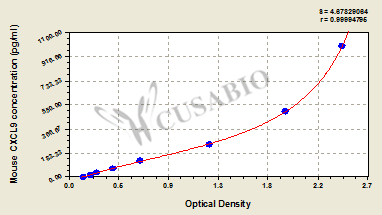The product CSB-EL006252MO is a sandwich ELISA kit developed to measure concentrations of mouse CXCL9 in serum, plasma, or tissue homogenates. This assay uses the sandwich enzyme immunoassay technique in combination with the enzyme-substrate chromogenic reaction to quantify the analyte in the sample. The color develops positively to the amount of CXCL9 in samples. The color intensity is measured at 450 nm via a microplate reader.
CXCL9, also known as MIG, can be produced during inflammatory conditions by myeloid cells within the tumor microenvironment. It attracts CXCR3-expressing cells including activated T and NK cells to the inflammatory environment and plays a role in responses to immune checkpoint therapy. Overexpression of CXCL9 has also been shown to reduce tumor progression and metastasis via the inhibition of angiogenesis. However, CXCL9 can act directly on CXCR3-expressing tumor cells to promote cell migration and epithelial-mesenchymal transition.






